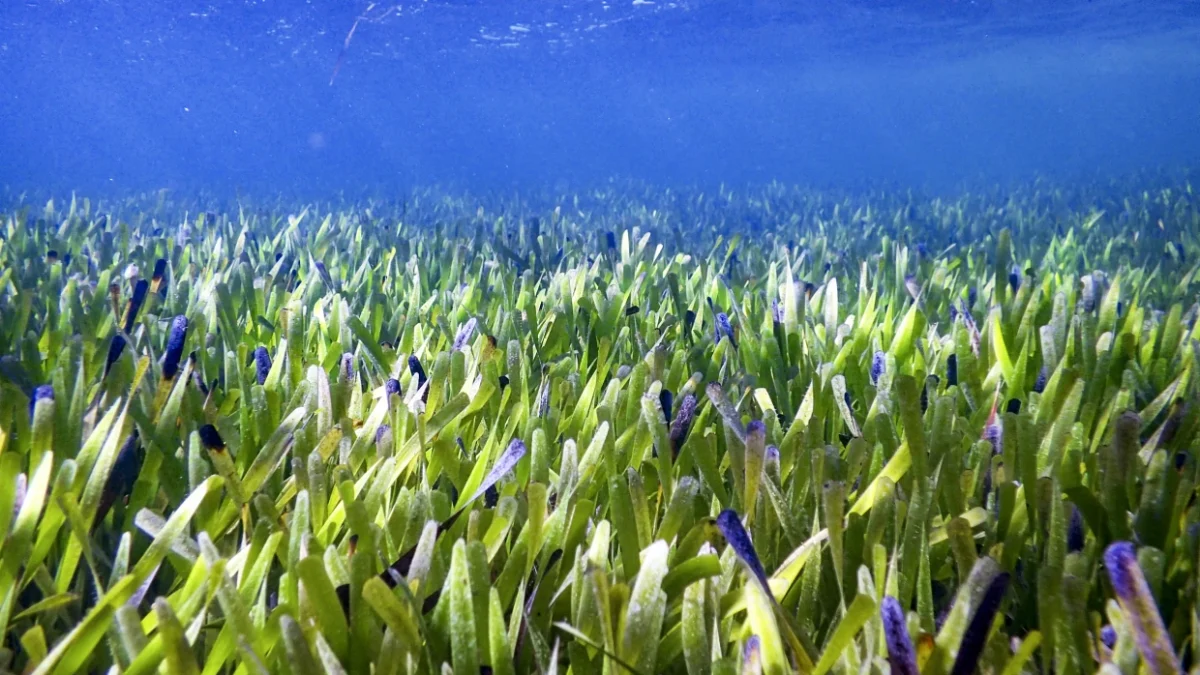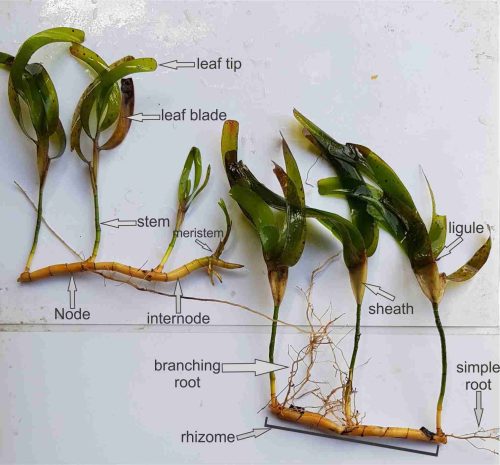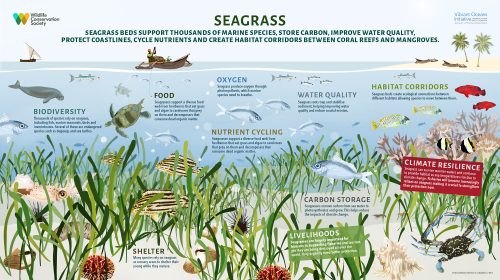SEAGRASS (LAMUN)

The Posidonia australis seagrass meadow in Australia's Shark Bay on Aug. 7, 2019 (Photo Credit : Rachel Austin)
The term seaweed is generally used to name the class of algae biota (seaweed), while the real seaweed (sea grass) referred to as seagrass is less popular in the community. Both are included in the group of plants that live in waters and play an important role in the ecosystem.
The main difference between sea grass and seaweed is that seaweed is a group of algae that live in marine waters. They belong to a group of non-flowering plants known as algae or algae. Seaweed comes in a variety of simpler shapes and sizes and has no true roots, stems, or leaves, their bodies are just thalluses. Body sizes range from microscopic to large and complex. They are attached to the substrate or float in the waters. Some common types of seaweed include green (e.g. Ulva), brown (e.g. Sargassum), and red (e.g. Porphyra). Seaweed has various uses, including as food, industrial raw materials, and also as a habitat for various marine organisms.
Sea grass is a group of flowering plants that live in shallow waters around the coast. It has roots, stems, and leaves similar to land plants. Sea grass usually forms underwater grasslands that are ecologically important. Some examples of common sea grass species include Zostera, Posidonia, and Thalassia. Sea grass has an important ecological role in providing shelter and breeding ground for various marine species, as well as helping to control coastal erosion and improve water quality.
In addition, the ecological role and function of these two plant groups in marine ecosystems can also be different.
CLASSIFICATION OF SEA GRASS
Kingdom: Plantae (plants)
Division: Magnoliophyta (flowering plants)
Class: Liliopsida (one-piece plants)
Order: Alismatales
Family: Posidoniaceae (e.g. Posidonia), Zosteraceae (e.g. Zostera), Hydrocharitaceae (e.g. Thalassia)
There are more than 60 species of sea grass found around the world. Some common species include Zostera, Posidonia, and Thalassia. Recorded several species in Indonesian waters include: Posidonia australis, Posidonia oceanica, Zostera capricorni, Zostera muelleri, Thalassia hemprichii, Halophila ovalis, Halophila decipiens, Halophila minor, Halodule uninervis, Enhalus acoroides. These species can be found in various waters in Indonesia, ranging from marine waters around major islands such as Java, Sumatra, and Kalimantan, to waters in islands such as Bali, Nusa Tenggara, and Maluku. Each seagrass species has different habitat preferences and environmental conditions, such as water depth, salinity, and level of sun exposure.
Seagrass usually grows in shallow water, especially near the coast. They need enough sunlight to carry out photosynthesis. Seaweed, on the other hand, can be found in a variety of marine habitats, including shallow, deep-water, and deeper waters. Some types of seaweed can even live in tidal zones or open areas in the ocean.
MORPHOLOGY AND REPRODUCTION

Photo Credit : Yoshida Rudi
The body has roots, stems and leaves similar to land plants. Their roots hold the soil at the bottom of the waters, while their leaves form underwater meadows.
Sea grass generally reproduces asexually by producing rhizomes or stolons that develop into new individuals. Some types of sea grass can also reproduce sexually with the help of wind or water to move pollen.
BENEFIT

Photo Credit : Wildlife Conservation Society
It has an ecological role in coastal ecosystems and is a habitat for various species of fish and invertebrates (mollusks and crustaceans). Sea grass also helps control coastal erosion and improve water quality by capturing sediment and nutrients.
Sea grass is the main food source for some marine animals. The leaves and stems of sea grass are consumed by herbivorous animals such as seagrasses, sea turtles, and a sea turtle. The abundant presence of sea grass provides an important food supply for marine food chains in coastal ecosystems.
Serving as coastal stabilization and erosion control, the strong root system of sea grass helps bind soil and sediment on the seafloor. This helps reduce coastal erosion and maintain shoreline stability. Sea grass can also dampen waves and water currents, helping to protect beaches from wave force and abrasion.
Sea grass has the ability to absorb and filter nutrients such as nitrogen and phosphorus from water. This helps control nutrient levels in the waters and prevents eutrophication, which is an excessive increase in nutrients that can lead to uncontrolled algae growth. Sea grass can also store nutrients in their tissues, preventing them from entering the wider ecosystem.
Sea grass has the ability to absorb carbon dioxide (CO2) from the atmosphere and store it in their tissues. This process helps reduce the concentration of CO2 in the atmosphere, which contributes to climate change mitigation and carbon sequestration.
With these roles, sea grass acts as an underwater "forest" that is important in maintaining biodiversity and the sustainability of coastal ecosystems. Conservation and protection efforts of sea grass are very important to maintain the balance of marine ecosystems and the benefits they provide for humanage and the environment.
As an underwater forest, sea grass is vulnerable to a variety of threats, including pollution, habitat destruction, climate change, and human activities such as destructive fishing or silting of waters.
It is important to maintain biodiversity and its ecological function. Conservation efforts that can be taken include the establishment of marine parks, habitat protection, pollution control, and public awareness of the importance of sea grass.
As an important component in fragile coastal ecosystems, maintaining and protecting sea grass is a way to maintain marine biodiversity and the sustainability of coastal ecosystems.
-YN

